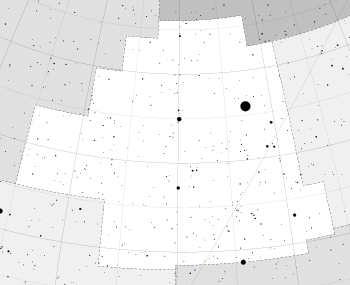
Back QY Aurigae AST QY Aurigae Spanish Gliese 268 Dutch QY Возничего Russian Gliese 268 Swedish கிளிசே 268 Tamil 格利泽268 Chinese
 A blue light light curve of a flare on Gliese 269. The intensity scale is relative to the star's quiescent brightness. Adapted from Pettersen (1975)[1] | |
| Observation data Epoch J2000 Equinox J2000 | |
|---|---|
| Constellation | Auriga |
| Right ascension | 07h 10m 01.83458s[2] |
| Declination | 38° 31′ 46.0672″[2] |
| Characteristics | |
| Spectral type | M5Ve + M5Ve[3] |
| U−B color index | +1.18[4] |
| B−V color index | +1.71[4] |
| Variable type | RS CVn |
| Astrometry | |
| Radial velocity (Rv) | 41.792 ± 0.025[5] km/s |
| Proper motion (μ) | RA: -437.44[2] mas/yr Dec.: -947.44[2] mas/yr |
| Parallax (π) | 165.2147 ± 0.0636 mas[6] |
| Distance | 19.741 ± 0.008 ly (6.053 ± 0.002 pc) |
| Orbit[5] | |
| Period (P) | 10.42672 ± 0.00006 d |
| Semi-major axis (a) | 0.1110 ± 0.0005″ |
| Eccentricity (e) | 0.3203 ± 0.0009 |
| Inclination (i) | 100.39 ± 0.03° |
| Longitude of the node (Ω) | 89.98 ± 0.07° |
| Argument of periastron (ω) (secondary) | 211.98 ± 0.19° |
| Semi-amplitude (K1) (primary) | 34.814 ± 0.036 km/s |
| Semi-amplitude (K2) (secondary) | 40.874 ± 0.052 km/s |
| Details[5] | |
| Gliese 268 A | |
| Mass | 0.22599(65) M☉ |
| Gliese 268 B | |
| Mass | 0.19248(56) M☉ |
| Other designations | |
| Database references | |
| SIMBAD | data |
| ARICNS | data |
Location of Gliese 268 in the constellation Auriga | |
Gliese 268 (QY Aurigae) is a RS Canum Venaticorum variable (RS CVn) star in the Auriga constellation. RS CVn variables are binary star systems with a strong magnetic field influenced by each star's rotation, which is accelerated by the tidal effects of the other star in the system.[7] Gliese 268 in particular is composed of a binary system of two M-type dwarfs, or red dwarfs, and is one of the one hundred closest star systems to the Earth. The primary component of the system has an apparent magnitude of 12.05, and the secondary component an apparent magnitude of 12.45.[citation needed] Neither is visible to the naked eye from Earth.[8]
In 1975, Bjørn Ragnvald Pettersen discovered that Gliese 268 is a flare star.[1] It received its variable star designation, QY Aurigae, in 1977.[9]
- ^ a b Pettersen, B. R. (June 1975). "Discovery of flare activity on the dM5e star Gliese 268". Astronomy & Astrophysics. 41: 87–90. Bibcode:1975A&A....41...87P. Archived from the original on 21 March 2023. Retrieved 31 October 2021.
- ^ a b c d Perryman; et al. (1997). "HIP 34603". The Hipparcos and Tycho Catalogues. Archived from the original on 2016-03-04. Retrieved 2015-09-21.
- ^ a b "V* QY Aur". SIMBAD. Centre de données astronomiques de Strasbourg. Retrieved 7 March 2015.
- ^ a b Mermilliod, J.-C. (1986). "Compilation of Eggen's UBV data, transformed to UBV (unpublished)". Catalogue of Eggen's UBV Data. Bibcode:1986EgUBV........0M.
- ^ a b c Barry, Richard K.; Demory, Brice-Olivier; Ségransan, Damien; Forveille, Thierry; Danchi, William C.; Di Folco, Emmanuel; Queloz, Didier; Spooner, H. R.; Torres, Guillermo; Traub, Wesley A.; Delfosse, Xavier; Mayor, Michel; Perrier, Christian; Udry, Stéphane (2012). "A Precise Physical Orbit for the M-Dwarf Binary Gliese 268". The Astrophysical Journal. 760 (1): 55. Bibcode:2012ApJ...760...55B. doi:10.1088/0004-637X/760/1/55. hdl:2060/20130013663. S2CID 1623628.
- ^ Brown, A. G. A.; et al. (Gaia collaboration) (2021). "Gaia Early Data Release 3: Summary of the contents and survey properties". Astronomy & Astrophysics. 649: A1. arXiv:2012.01533. Bibcode:2021A&A...649A...1G. doi:10.1051/0004-6361/202039657. S2CID 227254300. (Erratum: doi:10.1051/0004-6361/202039657e). Gaia EDR3 record for this source at VizieR.
- ^ "RS CVn Stars". Karl Schwarzschild Observatory. Archived from the original on 25 April 2021. Retrieved 26 August 2011.
- ^ "The 100 Nearest Star Systems". Research Consortium on Nearby Stars. Georgia State University. 1 January 2011. Archived from the original on 12 November 2007. Retrieved 26 August 2011.
- ^ Kukarkin, B. V.; Kholopov, P. N.; Fedorovich, V. P.; Kireyeva, N. N.; Kukarkina, N. P.; Medvedeva, G. I.; Perova, N. B. (March 1977). "62nd Name-List of Variable Stars" (PDF). Information Bulletin on Variable Stars. 1248: 1–25. Bibcode:1977IBVS.1248....1K. Retrieved 30 November 2024.
